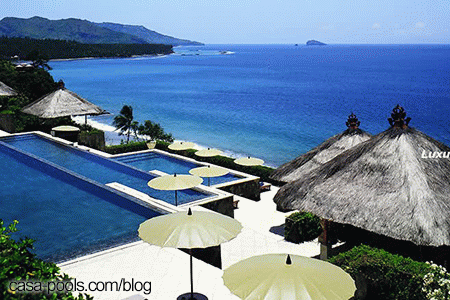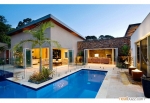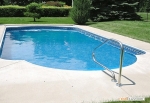|
|
|
Published On: February 20, 2014
By: Mark Wilson, Washington
|
GENERAL CATEGORY
|
SWIMMING POOLS TYPES
|

|
|
swimming pools types
|
The main difference between different types of pools is how the basin is constructed. There are several different pool styles, each with its own advantages and disadvantages.
Above-ground pools are the cheapest construction option, as well as the easiest to build. Most above-ground pools are made from prefabricated kits, which even an amateur can put together (though most people go with professional installers). First, the installers level off the ground to form a flat building surface. Then they assemble a perimeter track, which supports the outer wall (made of metal, plastic or wood). Next, they spread sand in the pool area and lay the plumbing. Finally, they secure the vinyl liner over the pool walls, fill the pool with water, smooth the liner and fasten it into place. As soon as they hook up the pump and filtering system, the pool is ready to go. The main disadvantage of this sort of pool is that it`s less durable than other designs, and generally less attractive. It`s also less permanent, which can be a good thing -- it`s relatively easy to disassemble the pool and move it to a new location.
Fiberglass pools are made from fiberglass-reinforced plastic, which has been molded into a basin shape. To install the pool, a construction crew digs an appropriately sized hole, lays the necessary plumbing, adds some sand filler and lowers the preformed pool structure into the hole. Then they level the pool, hook up all the plumbing and backfill in the area around the pool. Usually, the pool is surrounded by a concrete deck structure.
Vinyl-lined in-ground pools are a lot like above-ground pools, structurally, but they look more like conventional in-ground designs. The construction crew digs a hole and assembles a metal, plastic or wood frame wall around the hole`s perimeter. As in an above-ground pool, the crew lays sand along the bottom of the hole and secures the vinyl lining to the structural wall. These pools are a lot cheaper than other in-ground designs, but not as durable. Typically, the liner needs to be replaced every 10 years or so.
Gunite pools are the most popular design in much of the United States. To build one of these pools, the construction crew digs a hole, puts the plumbing in place and assembles a framework grid with 3/8-inch steel reinforcing rods (rebar). The rebar rods are spaced about 10 inches apart, and secured together with wire. When the grid is in place, the crew sprays a heavy coating of gunite, a mixture of cement and sand, around the rebar. The sprayer unit combines dry gunite mix with water just before spraying -- this produces the wet concrete material. The crew trowels the gunite smooth and lets it sit for a week or so before applying a smooth finish to the rough surface. The most popular finish is called plaster (actually a mixture of cement and marble sand), but a lot of people finish their pools with special concrete paint. Gunite pools can also have tile, exposed aggregate or even fiberglass finishes. Gunite pools (and their cousins, shotcrete pools) are highly durable, and they can be built in any shape or size.
Poured-concrete pools are similar to gunite pools, but they`re a lot harder to build. Instead of spraying concrete material around a rebar framework, concrete is actually poured into conventional wooden forms. With the rise of gunite methods, poured-concrete pool construction has mostly fallen by the wayside. In masonry block pools, the walls are constructed with concrete blocks.
*from HowStuffWorks
|
|
|
|
Everything Swimming Pools
|
|
|
|
|
|
 |
|
15 transparent glass swimming pool safety fences
|
|
read more...
|
|
|
July 10, 2014 |
|
|
|
 |
|
12 tips to save money on your pool the eco-friendly pool
|
|
read more...
|
|
|
August 19, 2014 |
|
|
|
 |
|
health safety tips before swimming pools
|
|
read more...
|
|
|
February 25, 2014 |
|
|
|
|
|
|
�
|
|

|
|
|
|
